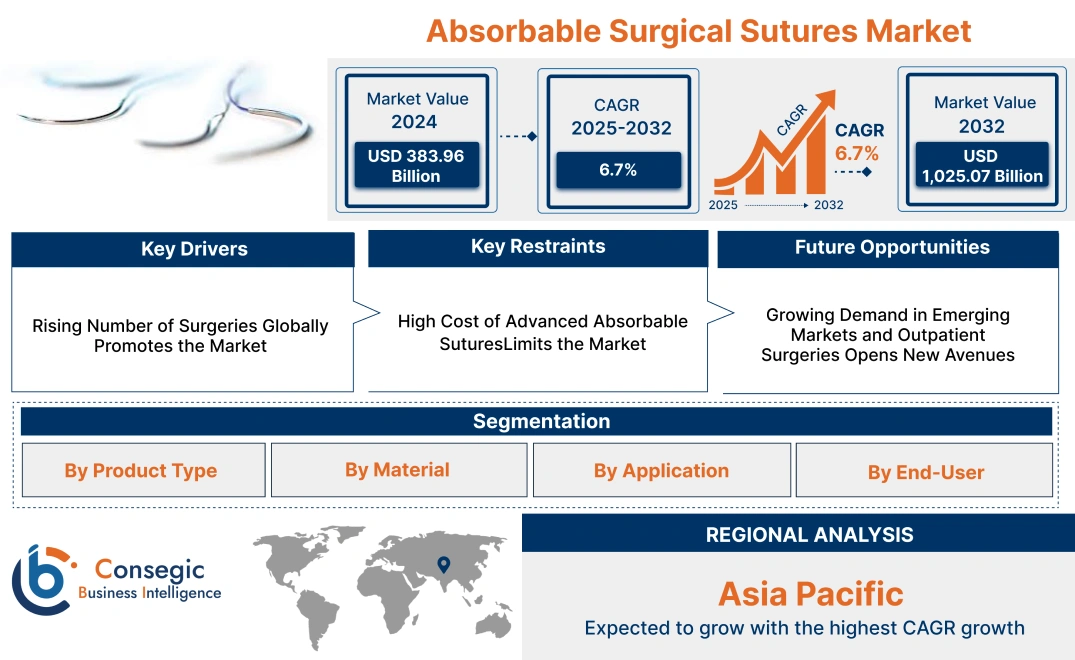- Summary
- Table Of Content
- Methodology
Absorbable Surgical Sutures Market Size:
Absorbable Surgical Sutures Market size is estimated to reach over USD 5.08 Billion by 2031 from a value of USD 3.01 Billion in 2023 and is projected to grow by USD 3.16 Billion in 2024, growing at a CAGR of 6.7% from 2024 to 2031.
Absorbable Surgical Sutures Market Scope & Overview:
Absorbable surgical sutures are specialized medical threads designed to dissolve naturally in the body over time, eliminating the need for suture removal after surgery. These sutures are made from materials like polyglycolic acid, polylactic acid, and catgut, which are absorbed by the body through enzymatic or hydrolytic processes. Absorbable sutures are widely used in surgeries where internal tissues require temporary support during healing, such as gastrointestinal, gynecological, and orthopedic procedures. Their use reduces the risk of infection and minimizes patient discomfort compared to non-absorbable alternatives. Advancements in suture materials and technologies have enhanced the performance and safety of these sutures. End-use sectors such as hospitals, surgical centers, and specialty clinics are key adopters, as absorbable sutures continue to play a vital role in improving surgical outcomes and patient recovery.
Absorbable Surgical Sutures Market Dynamics - (DRO) :
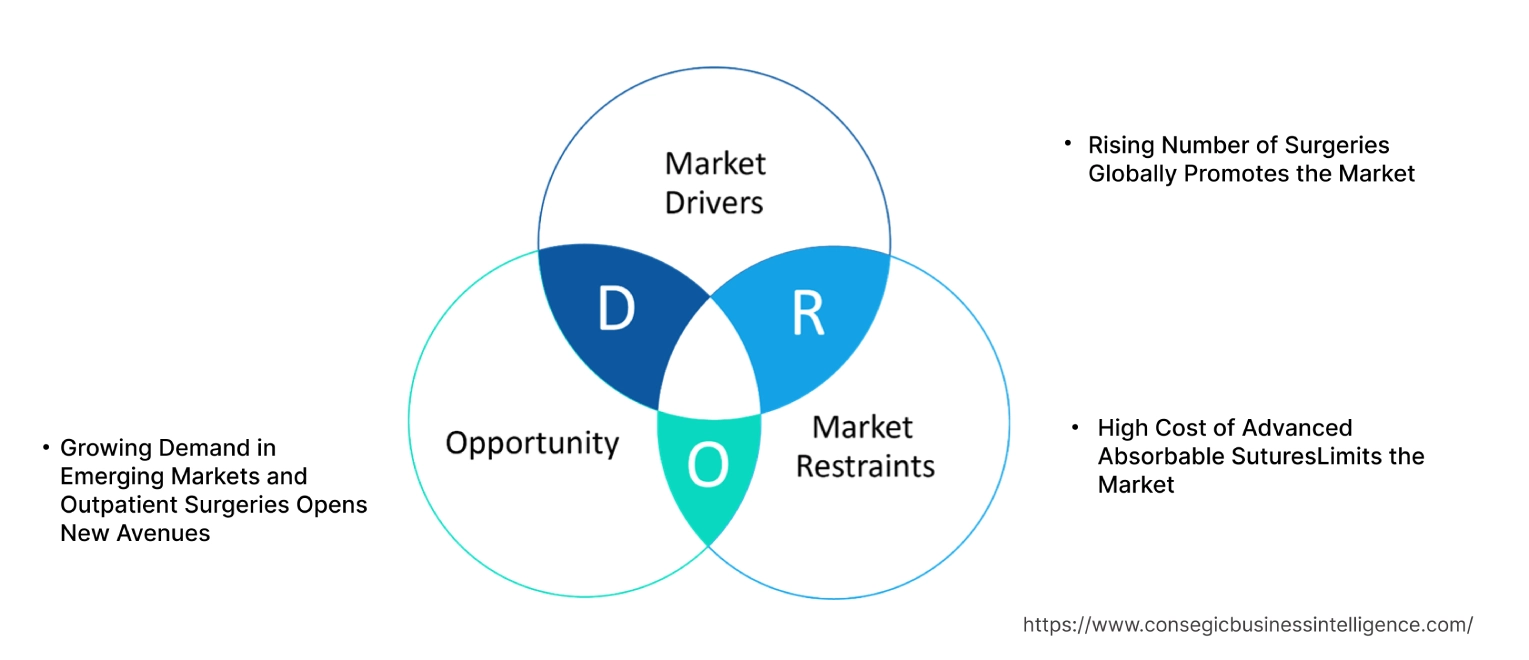
Key Drivers:
Rising Number of Surgeries Globally Promotes the Market
With the growing prevalence of chronic diseases such as cancer, cardiovascular disorders, and orthopedic conditions, the need for surgeries continues to rise, particularly in both developed and emerging economies. Absorbable sutures are preferred in many surgical procedures, including gastrointestinal, gynecological, and orthopedic surgeries, due to their ability to dissolve naturally within the body, eliminating the need for suture removal. The trend toward minimally invasive surgeries has also increased the adoption of absorbable sutures, which offer faster healing and reduce the risk of infection compared to non-absorbable alternatives. The absorbable surgical sutures market growth is further supported by advancements in suture material technology, such as synthetic and antimicrobial-coated sutures, which enhance performance and reduce complications.
Key Restraints :
High Cost of Advanced Absorbable Sutures Limits the Market
One of the major restraints limiting the market is the high cost associated with advanced suture materials, particularly synthetic absorbable sutures. While traditional absorbable sutures made from natural materials like catgut are more affordable, newer synthetic alternatives, such as polyglycolic acid (PGA) and polydioxanone (PDO), come at a higher cost. This makes them less accessible, especially in low-income and rural healthcare settings where budget constraints are more pronounced. Additionally, the cost factor can limit their widespread adoption in regions with less-developed healthcare infrastructure, where cost-effective solutions are prioritized. Healthcare providers in these regions may opt for cheaper non-absorbable sutures, further restraining absorbable surgical sutures market demand.
Future Opportunities :
Growing Demand in Emerging Markets and Outpatient Surgeries Opens New Avenues
Emerging markets, particularly in Asia-Pacific and Latin America, present significant absorbable surgical sutures market opportunities. As healthcare infrastructure improves and access to surgical treatments expands in these regions, the need for advanced surgical products, including absorbable sutures, is rising. Additionally, the increasing focus on outpatient surgeries and day-care procedures in developed markets is further boosting demand for absorbable sutures. These sutures are favored in outpatient settings due to their ability to reduce the need for follow-up visits for suture removal, leading to better patient outcomes and cost savings for healthcare providers. The growing trend toward outpatient care, combined with the rising number of surgical procedures in emerging regions, is expected to offer substantial opportunities for absorbable surgical sutures market expansion.
Absorbable Surgical Sutures Market Segmental Analysis :
By Product Type:
Based on product type, the market is segmented into monofilament sutures and multifilament (braided) sutures.
The monofilament sutures segment accounted for the largest revenue share of the total absorbable surgical sutures market share in 2023.
- Monofilament sutures are widely used due to their smooth structure, which reduces tissue trauma and minimizes infection risks during surgery.
- These sutures are known for their ability to glide easily through tissues without causing significant friction, making them ideal for delicate surgeries such as cardiovascular and ophthalmic procedures.
- The increasing preference for minimally invasive surgeries, where monofilament sutures are highly favored, has driven the segment.
- Additionally, their ability to maintain tensile strength for an extended period before being absorbed adds to their popularity.
- Thus, the market trends analysis shows that monofilament sutures dominate the market due to their smooth structure, minimizing tissue trauma, and their widespread use in delicate surgeries like cardiovascular and ophthalmic procedures, driving the absorbable surgical sutures market growth.
The multifilament (braided) sutures segment is anticipated to register the fastest CAGR during the forecast period.
- Multifilament sutures, or braided sutures, offer greater flexibility and better knot security compared to monofilament sutures.
- Their braided structure provides enhanced handling and ease of knot placement, making them ideal for procedures requiring more tensile strength, such as orthopedic and general surgeries.
- The increasing number of surgical procedures globally, especially in orthopedic and trauma care, is driving the need for braided sutures.
- Additionally, advancements in coating technologies that improve the handling characteristics of braided sutures without compromising their absorption rates are further boosting their adoption.
- Thus, the market trends analysis shows that multifilament sutures are expected to grow rapidly due to their superior knot security and flexibility, especially in surgeries requiring greater tensile strength, such as orthopedic and general procedures, boosting the absorbable surgical sutures market trends.
By Material:
Based on material, the market is segmented into synthetic sutures (polyglycolic acid (PGA), polyglactin 910, polydioxanone (PDO), polyglytone, others) and natural sutures.
The synthetic sutures segment accounted for the largest revenue share of the overall absorbable surgical sutures market share in 2023.
- Synthetic sutures, particularly those made from polyglycolic acid (PGA), polyglactin 910, and polydioxanone (PDO), are widely preferred due to their predictable absorption rates and higher tensile strength compared to natural sutures.
- These materials provide excellent wound support during the critical healing period before gradually being absorbed by the body.
- Synthetic sutures also have lower chances of causing tissue reactions, making them suitable for a variety of surgical applications, including cardiovascular and gynecological surgeries.
- The increasing demand for reliable, biocompatible suture materials is driving the dominance of synthetic sutures in the market.
- Thus, the segmental trends analysis shows that synthetic sutures lead the market due to their superior tensile strength, predictable absorption rates, and biocompatibility, making them ideal for a wide range of surgical applications, driving the absorbable surgical sutures market demand.
The polydioxanone (PDO) segment is anticipated to register the fastest CAGR during the forecast period.
- Polydioxanone (PDO) sutures are known for their prolonged absorption period and high tensile strength, making them suitable for surgeries where extended wound support is critical, such as cardiovascular and orthopedic procedures.
- The growing number of complex surgeries, particularly in cardiovascular care, where longer wound support is required, is driving the need for PDO sutures.
- Additionally, advancements in PDO-based sutures that enhance their handling and knot security are contributing to the segment's rapid development.
- Thus, the absorbable surgical sutures market analysis shows that Polydioxanone (PDO) sutures are expected to grow rapidly, driven by their long absorption period and suitability for complex surgeries requiring extended wound support, especially in cardiovascular and orthopedic procedures.
By Application:
Based on application, the market is segmented into cardiovascular surgery, general surgery, orthopedic surgery, gynecological surgery, ophthalmic surgery, and others.
The cardiovascular surgery segment accounted for the largest revenue share of 35.18% in 2023.
- Absorbable sutures are critical in cardiovascular surgeries due to their ability to provide temporary wound support while minimizing the risk of infection.
- The increasing prevalence of cardiovascular diseases globally, coupled with advancements in minimally invasive cardiac procedures, is driving the need for absorbable sutures.
- Sutures such as polydioxanone (PDO) are particularly favored in cardiovascular surgeries due to their prolonged absorption time, which ensures wound stability during the critical healing period.
- The rising number of cardiovascular surgeries, especially in regions with aging populations, further contributes to the dominance of this segment.
- Hence, the segmental trends analysis shows that cardiovascular surgery leads the market due to the increasing prevalence of cardiovascular diseases and the critical role absorbable sutures play in providing temporary wound support during cardiac procedures, boosting the absorbable surgical sutures market trends.
The orthopedic surgery segment is anticipated to register the fastest CAGR during the forecast period.
- Orthopedic surgeries often require sutures with high tensile strength to stabilize tissues and bones during the healing process.
- Absorbable sutures, particularly multifilament types, are widely used in these procedures to minimize post-operative complications while providing the necessary wound support.
- The growing incidence of orthopedic conditions such as fractures, sports injuries, and joint replacements is driving the need for absorbable sutures.
- Additionally, the increasing adoption of minimally invasive orthopedic procedures, which require precision and reliable wound closure, is contributing to the rapid development of the segment.
- Thus, the absorbable surgical sutures market analysis depicts that orthopedic surgery is set to grow rapidly, driven by the increasing incidence of orthopedic conditions and the need for sutures with high tensile strength for wound stabilization in minimally invasive procedures.
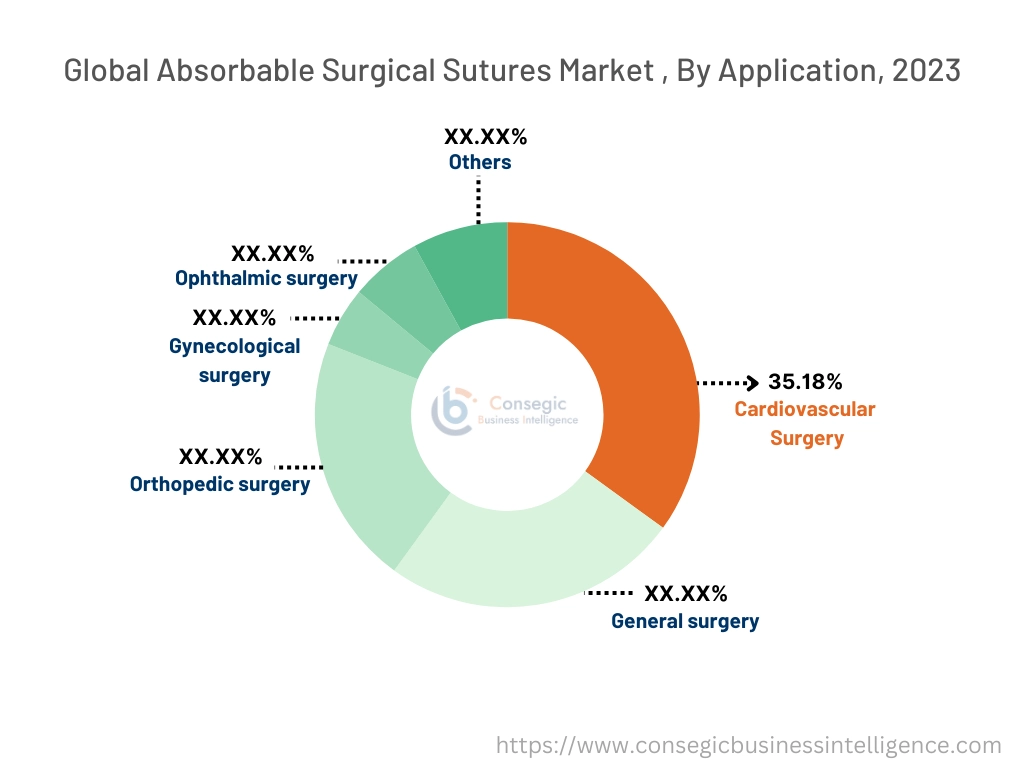
By End-User:
Based on end-user, the market is segmented into hospitals, ambulatory surgical centers, specialty clinics, and others.
The hospitals segment accounted for the largest revenue share in 2023.
- Hospitals are the largest end-users of absorbable sutures due to the high volume of surgeries performed in these settings, ranging from cardiovascular and orthopedic procedures to general surgeries.
- Hospitals have access to advanced surgical technologies and are equipped to handle complex surgical cases, which often require absorbable sutures for wound closure.
- The increasing number of surgeries being performed in hospitals, driven by the rising prevalence of chronic diseases and trauma cases, has solidified the dominance of this segment in the market.
- Hence, the segmental trends depicts that hospitals lead the market due to the high volume of surgeries performed and the critical need for absorbable sutures in complex procedures across various specialties.
The ambulatory surgical centers segment is anticipated to register the fastest CAGR during the forecast period.
- Ambulatory surgical centers (ASCs) are increasingly preferred for outpatient surgeries due to their cost-effectiveness and shorter recovery times.
- ASCs often perform a wide range of procedures, including general, gynecological, and orthopedic surgeries, which require absorbable sutures for efficient wound closure.
- The growing trend toward outpatient surgeries, particularly in developed regions, is driving the adoption of absorbable sutures in ASCs.
- Additionally, advancements in minimally invasive surgical techniques, which are commonly performed in ASCs, further boost the adoption of absorbable sutures in these settings.
- Ambulatory surgical centers are expected to grow rapidly as outpatient surgeries become more popular, with the increasing adoption of absorbable sutures in minimally invasive procedures contributing to the segment's progress.
Regional Analysis:
The regions covered are North America, Europe, Asia Pacific, the Middle East and Africa, and Latin America.
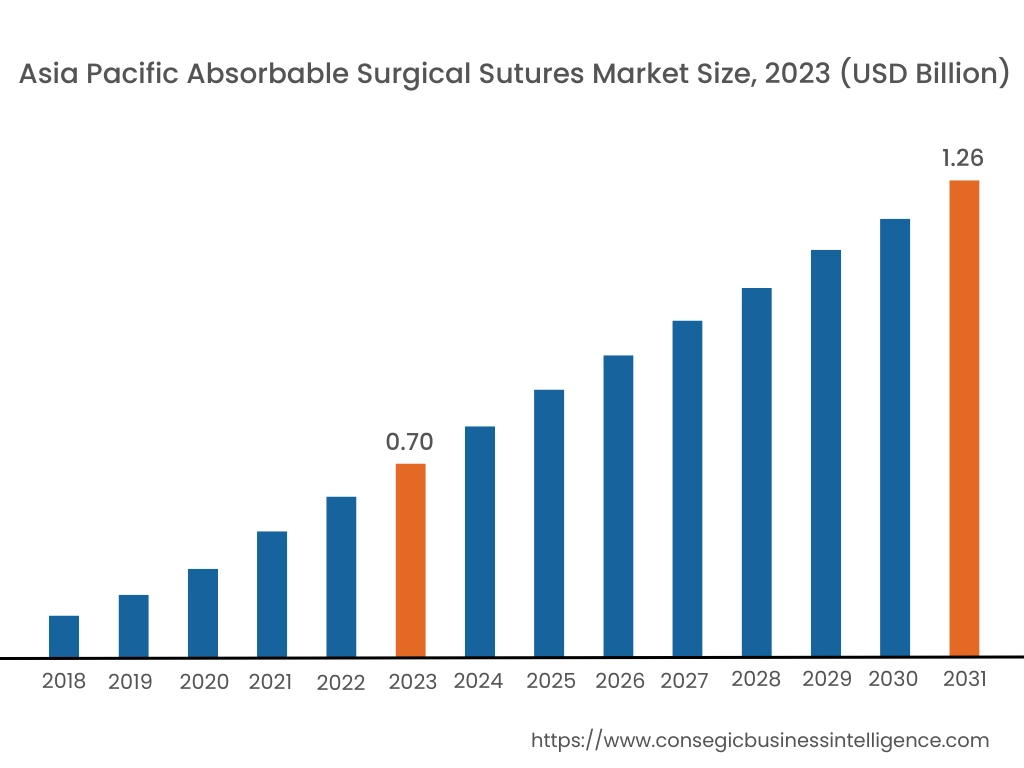
Asia Pacific region was valued at USD 0.70 Billion in 2023. Moreover, it is projected to grow by USD 0.74 Billion in 2024 and reach over USD 1.26 Billion by 2031. Out of this, China accounted for 32.5% of the total market share. Asia-Pacific is the fastest-growing region in the market, driven by increasing healthcare investments and the rising number of surgeries in countries like China, India, and Japan. Rapidly expanding healthcare infrastructure, along with a growing elderly population and increasing prevalence of chronic conditions, supports market development. Government initiatives to improve healthcare access in rural areas further stimulate demand for absorbable sutures. However, limited access to advanced surgical technologies in certain regions and a shortage of skilled surgeons may hinder growth.
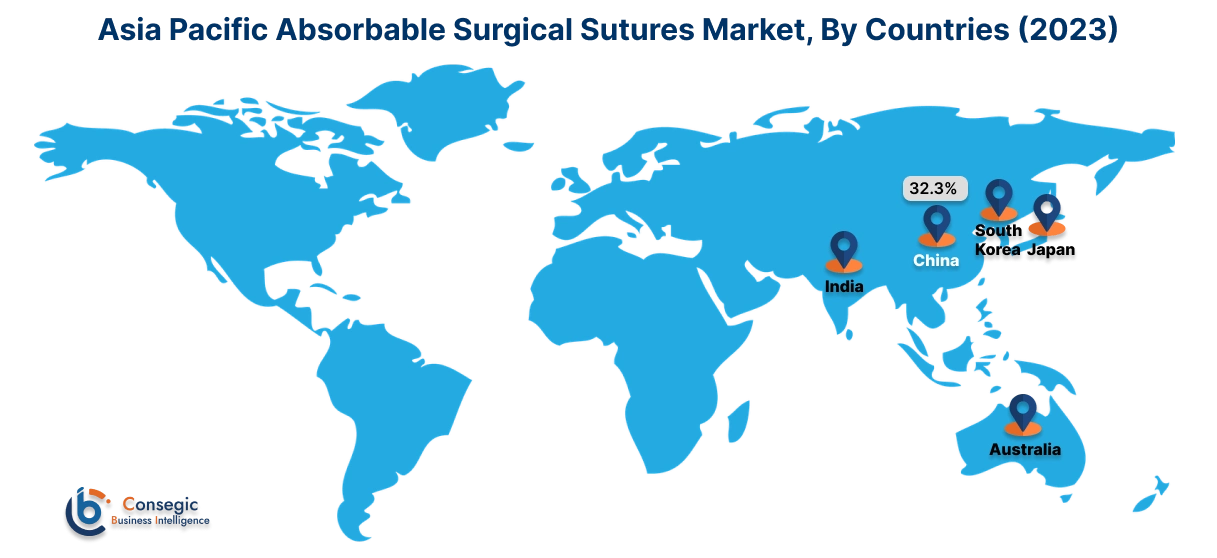
North America holds a dominant position in the market, driven by the high volume of surgical procedures performed in the U.S. and Canada, particularly in orthopedic and cardiovascular surgeries. The region benefits from a well-established healthcare infrastructure and strong investments in advanced surgical technologies. The aging population and high prevalence of chronic diseases further boost demand for absorbable sutures. However, market growth may be challenged by the increasing use of minimally invasive surgical techniques, which require fewer sutures.
Europe represents a significant market for absorbable surgical sutures, with Germany, France, and the UK leading due to the region's advanced healthcare systems and rising demand for surgical interventions. The high prevalence of cardiovascular diseases and orthopedic disorders among the aging population drives the need for surgical sutures. Additionally, innovations in suture materials and government initiatives to improve healthcare quality contribute to market expansion. However, stringent regulations and the high costs of advanced surgical sutures can slow market growth.
The Middle East & Africa region is witnessing moderate growth in the market, particularly in Saudi Arabia, the UAE, and South Africa. Growing investments in healthcare infrastructure and the rising demand for advanced surgical solutions drive market. The increasing prevalence of chronic diseases and an aging population have led to a higher demand for surgical interventions. However, limited healthcare access and the high cost of advanced sutures in certain regions remain challenges to absorbable surgical sutures market expansion.
Latin America is an emerging market for absorbable surgical sutures, with Brazil and Mexico being key contributors. The region's growth is driven by the rising number of surgical procedures, particularly in the areas of orthopedics, gynecology, and general surgeries. An increasing focus on improving healthcare infrastructure and access to surgical care supports market growth. However, economic instability and a lack of advanced surgical equipment in some countries may restrict market expansion in the region.
Top Key Players & Market Share Insights:
The absorbable surgical sutures market is highly competitive with major players providing products to the national and international markets. Key players are adopting several strategies in research and development (R&D), product innovation, and end-user launches to hold a strong position in the global absorbable surgical sutures market. Key players in the absorbable surgical sutures industry include-
- Ethicon (Johnson & Johnson) (USA)
- Medtronic plc (Ireland)
- B. Braun Melsungen AG (Germany)
- Smith & Nephew plc (UK)
- Boston Scientific Corporation (USA)
- Teleflex Incorporated (USA)
- DemeTECH Corporation (USA)
- Internacional Farmacéutica (Mexico)
- Sutures India Pvt Ltd (India)
- Melsungen AG (Germany)
Recent Industry Developments :
Business Expansion:
- In April 2024, Samyang Holdings Corp. opened a $22 million surgical suture manufacturing facility in Hungary, strengthening its presence in Europe. Located near Budapest, the plant is projected to produce approximately 62,000 miles of biodegradable suture yarn annually by 2025, marking a significant achievement for the South Korean company.
Product Launch:
- In August 2023, Healthium Medtech launched TRUMAS, India's first dedicated range of sutures for minimal access surgery, which addresses specific challenges encountered during suturing. This innovation is set to transform suturing practices in minimal access procedures and highlights Healthium's commitment to advancing medtech in India.
Approvals:
- In September 2023, Genesis MedTech received approval from China's NMPA to launch antibacterial absorbable sutures, which aim to enhance healing outcomes and reduce infection risks in the market.
Absorbable Surgical Sutures Market Report Insights :
| Report Attributes | Report Details |
| Study Timeline | 2018-2031 |
| Market Size in 2031 | USD 5.08 Billion |
| CAGR (2024-2031) | 6.7% |
| By Product Type |
|
| By Material |
|
| By Application |
|
| By End-User |
|
| By Region |
|
| Key Players |
|
| North America | U.S. Canada Mexico |
| Europe | U.K. Germany France Spain Italy Russia Benelux Rest of Europe |
| APAC | China South Korea Japan India Australia ASEAN Rest of Asia-Pacific |
| Middle East and Africa | GCC Turkey South Africa Rest of MEA |
| LATAM | Brazil Argentina Chile Rest of LATAM |
| Report Coverage |
|
Key Questions Answered in the Report
What is the projected size of the Absorbable Surgical Sutures Market? +
Absorbable Surgical Sutures Market size is estimated to reach over USD 5.08 Billion by 2031 from a value of USD 3.01 Billion in 2023 and is projected to grow by USD 3.16 Billion in 2024, growing at a CAGR of 6.7% from 2024 to 2031.
What are absorbable surgical sutures used for? +
Absorbable surgical sutures are used to close internal wounds or surgical incisions. They are designed to break down naturally within the body over time, eliminating the need for removal and reducing the risk of post-surgical complications. They are commonly used in procedures such as gastrointestinal, gynecological, and orthopedic surgeries.
Which region is expected to witness the highest growth in the Absorbable Surgical Sutures Market? +
The Asia-Pacific region is expected to witness the highest growth in the market due to the rising number of surgeries, improving healthcare infrastructure, and increasing awareness about advanced surgical techniques in countries like India and China.
What are the key trends influencing the Absorbable Surgical Sutures Market? +
Key trends include the development of sutures made from synthetic materials like polyglycolic acid and polydioxanone, which offer better strength and controlled degradation. Additionally, innovations in antibacterial sutures are gaining traction, helping to reduce infection rates in post-operative wounds.
